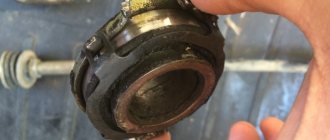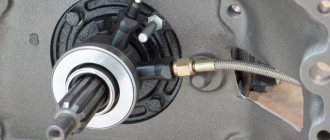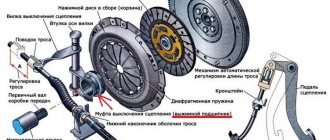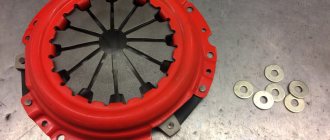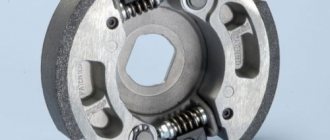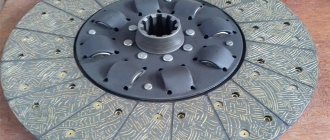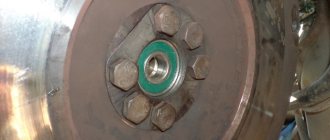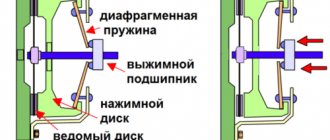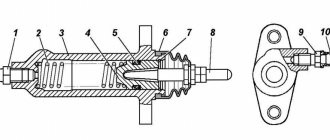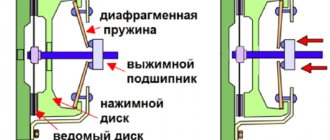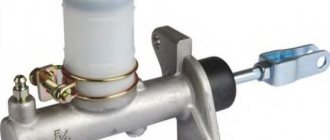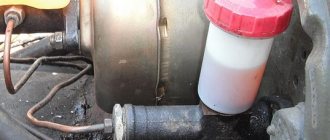- ➡️ Conclusions
The clutch is one of the most important components of a car's transmission. It must withstand enormous loads during movement. One of the main parts that ensure the operation of the clutch is the release bearing (VP or clutch release clutch).
Its purpose, types and characteristic faults, and how to replace the bearing are described in a detailed article.
Purpose of the clutch bearing
The clutch is designed to stop the supply of torque from the engine to the gearbox. While driving, when the driver presses the clutch pedal, the transmission between the engine and the gearbox is interrupted.
For this purpose, the system provides a release bearing. His tasks:
- Provide force on the petals of the basket;
- Smoothly remove the input shaft from contact with the flywheel;
- Isolate the clutch drive from torque loads when pressed.
The basket is rigidly connected to the flywheel, so it rotates at constant speed.
The function of the clutch release clutch is to press the housing petals without causing harm to the parts. At the moment of contact, the outer race begins to rotate at the same speed as the engine, while smoothly transferring force from the person’s leg.
Mechanical wear of the cylinder components.
If air enters the connecting hoses and sealing collars, microcracks may appear. If this happens, don't panic. To eliminate this problem, you will need to bleed the system. Pumping does not require special skills or tools; it is familiar to almost all owners of their own vehicles.
Is it possible to independently determine whether the clutch master cylinder is faulty? Of course. To do this, you need to determine the location of the leak. To do this, brake fluid is usually added to the cylinder. A leak can be dangerous in the following ways: it will be impossible to break the connection between the wheels and the engine, which can cause an accident. The cause of the leak cannot always be determined during a routine inspection with adding brake fluid. If the problem lies directly in the cylinder, then it will be necessary to disassemble the mechanism. However, if the connecting pipes are leaking, then do not worry, because they can be easily replaced.
Types of bearings
There are two main types of bearings used in clutch systems of manual transmissions.
Mechanical
Mechanical clutches are found on Soviet-made cars. Some modern models, such as Priora, are also equipped with a classic system. It is unpretentious and simple in design.
The mechanism consists of:
- pedals in the cabin;
- metal cable in a protective braid;
- forks;
- release clutch.
When the unit is turned on, the part does not participate in the operation of the box. When you press the pedal, a cable is pulled, which moves the fork. The clutch shifts towards the petals of the diaphragm spring. The disc comes out of contact with the flywheel.
Mechanical systems are gradually giving way to others and are becoming less common. The reason is low efficiency, which requires a lot of force on the pedal.
Hydraulic
The drive is designed according to the brake system diagram:
- master cylinder;
- pipeline;
- fluid reservoir;
- highway;
- working hydraulic cylinder.
When you press the pedal, the circuit pressure increases. The fluid passes from the master cylinder reservoir to the slave cylinder, which moves the clutch to the petals of the basket. The clutch disengages.
Hydraulics have greater efficiency than mechanics. The viscosity of the fluid contributes to the smooth shutdown of the gearbox. The pedal is light and does not cause discomfort.
The disadvantage of the system is the complexity of the design. With high mileage, air may enter the hydraulic system. Depressurization of the circuit causes the pedal to fail and the clutch stops working.
Combined
Combined units include mechanical and hydraulic drive elements. The system can be found in classic VAZ models. Combines the advantages of two types in one device.
When you press the clutch pedal, the hydraulic system is activated. Increased pressure is generated in the circuit, performing mechanical work. But the fluid does not push the release clutch. The working cylinder rod moves the yoke, which moves the part along the surface of the drive shaft.
Further, the operating principle is the same as the mechanical system. The cage presses the diaphragm blades, the driven disk comes out of contact, and the transmission is disconnected from the engine.
Operating principle
The classic dry clutch design used on passenger cars is permanently closed. The design of such a unit includes a basket with a drive disk, which is bolted to the flywheel. Between them there is a driven disk mounted on the splines of the gearbox input shaft. Due to a powerful diaphragm spring, the driven disk constantly presses the drive disk against the flywheel, which is why this circuit is called closed.
The task of the release bearing is to open the flow. The driver, pressing the clutch pedal, uses a drive to move the bearing along a guide sleeve mounted on the input shaft towards the basket. Due to the force of the driver's foot, this bearing presses on the diaphragm, resulting in the movement of the drive disk along the guides inside the basket. It moves away and releases the driven disk - the transmission of rotation is interrupted. After releasing the pedal, the bearing moves towards the gearbox, and the spring returns the drive disk to its place - the flow resumes.
Clutch assembly design and bearing arrangement
Mechanical clutch has two main elements:
- Pressure disk. It is often called a basket. Leaf springs are built into the body. They are connected to a round plate that presses the driven disk. Pressing on the springs is carried out by the outer ring and causes the platform to shift along the axis.
- Driven disk. It consists of friction sectors, a splined groove for connecting to the input shaft, and a radial disk. Damper springs are installed all around to absorb shocks.
The release bearing disengages the driven disk. It is installed on the input shaft. The body of the part is fixed to a fork, which fits into the protective bell of the gearbox. Pressing the pedal moves the bearing towards the petals of the basket.
Squeezing devices are technologically similar and consist of:
- inner race (mounting hole for the shaft);
- rolling mechanism (roller or ball);
- external housing with a pressure pad.
Depending on the design, the rolling elements are made of hardened metal. The coupling body is cast from steel or cast iron.
Causes of bearing failure
The operation of the squeezing device is subject to constant dynamic loads. Engine power depends on speed, because of this the impact on the part is not constant.
Worth remembering:
Torque exerts load only when the pedal is pressed. Based on this, we highlight the most common symptoms of a faulty release bearing, described below.
- Holding the clutch in the disengaged state for a long time. Uneven transmission of force leads to increased wear of the part.
- Sharp throws and pedal presses. This style is typical for lovers of aggressive driving. Great force is immediately applied to the part, which can cause breakage.
- Incorrect setting of the cable stroke or rod of the working cylinder. The nickel ends up in constant contact with the forks.
All causes of malfunctions come down to the human factor. Improper handling of the pedal results in sudden loads on the part. There are frequent cases of complete destruction of the VP.
Consequences of untimely replacement
Ignoring any malfunctions will lead to more serious damage over time, and failure of the release bearing is no exception. The following may occur:
- due to severe overheating, the clutch disc lining is destroyed;
- the appearance of extraneous noise;
- plug damage;
- violation of the integrity of the spring petals;
- deformation of guide bushings.
If you don't change the release bearing
On a note! In order not to overpay for repairs, you need to react to the appearance of the first suspicious sounds in the clutch operation.
Possible malfunctions, their symptoms and diagnostics
No special equipment is required for diagnosis. The symptoms are eloquent and difficult to confuse with other elements. It is enough to listen to the car yourself while pressing the pedal.
Signs of a faulty release bearing:
- whistling, crunching, localized in the pedal area;
- characteristic knocking sound of the drive when the engine is running;
- shocks when pressed, pedal wedge;
- Difficult gear shifting, sometimes accompanied by extraneous sounds.
How to check the release bearing:
- start the engine, put the gear in neutral;
- press the clutch, listen to extraneous noises;
- engage the gear and slowly release the pedal.
The occurrence of at least one of the described symptoms indicates the need to replace the bearing. Delaying the procedure threatens its complete destruction.
How to check the clutch release on a car:
Signs of a faulty release bearing:
When diagnosing, remember the features of VP:
The sound of a pressed pedal does not always indicate a malfunction. This is normal in cold weather. Rollers (balls) are made of steel that does not have large linear expansion. The holder is cast from heat-treated metal. This difference can cause a gap to appear that is acceptable for operation.
How to replace a release bearing
Operations for replacing different types of squeezing devices have similar technological steps. Let's look at mechanical and hydraulic structures using specific examples.
Mechanical clutch type. Step-by-step instruction.
For clarity, let’s take a VAZ 2114 car. Before starting disassembly, ensure sufficient lighting of the gearbox. Prepare your workplace and tools.
Advice:
It is recommended to perform the gearbox removal operation in a pit. This ensures full access to the checkpoint. The help of a partner will not be superfluous.
Photo report of gearbox removal:
After removing the transmission from the vehicle, you can proceed to replacing the spare part:
- Carefully inspect the inside of the bell. Make sure the fork fastening is intact. If there are signs of damage, replace it.
- Locate the edge of the spring that secures the clutch. Use a screwdriver to pry off the bearing.
- Clean the shaft splines of old grease and dirt.
- Let's start replacing the part. Lubricate the seating surfaces and gearbox shaft. Use CV joint lubricant.
- We put the new part on the shaft. Install the retaining spring.
- Check the axial travel of the coupling. It should be free of jams.
- We check the rotation of the rollers (balls). There should be no rolls, wedging or other defects in the process.
This completes the replacement. The gearbox can be installed in reverse order.
Advice:
Be sure to check the condition of the driving and driven clutch discs and basket.
Photo report of VP replacement
Hydraulic clutch type. Step-by-step instruction.
As an example, consider a Ford Focus 2. The preparatory stage consists of removing the gearbox from the engine.
Advice:
The box mounting bolts vary in length. Be sure to label them before unscrewing.
Photo report of gearbox removal:
Replacement of the release bearing is carried out according to the following plan:
- We inspect the inside of the protective casing. We remove oil, dirt, and wear products from friction linings and clean the space.
- Unscrew the bolts securing the spare part housing. Remove the element from the gearbox shaft.
- We clean the seating surface from traces of oil and dirt.
- We install the new part on the shaft. Tighten the bolts of the fluid coupling housing.
- We check that the pipe-to-fitting adapter is installed correctly.
- We install the transmission on the car according to the instructions.
Upon completion, it is necessary to bleed the hydraulic drive system to remove air. It is recommended to carry out the operation with a partner. After each deep pedal press, unscrew the outlet fitting and release the air. Repeat the procedure several times.
Advice:
Carefully inspect the fluid inside the clutch reservoir. It should not be cloudy or dirty. Otherwise, remove it with a syringe, fill in a new one and bleed the system.
Photo report of VP replacement
Instructions for replacing the Ford Focus 2 clutch with your own hands, cost of the part
We remove the manual transmission on a Ford Focus 2 to replace the hydraulic release cylinder. At home. PART 2
Old clutch disc New clutch disc The third day began with an attempt to remove the flywheel... the idea failed, since the engine was supported by only one support and a jack, which did not add stability to the unit at all, and when trying to unscrew at least one bolt, every now and then it rocked , tried to fall.
Replacement kit To replace the unit yourself, you need to prepare the following tools:
The reason is a circuit malfunction. By pressing the latch, disconnect the wiring block from the reverse light switch
Despite the fact that the left one must be knocked out very carefully from the inside, unless of course you have a special tool, other options in the form of a crowbar may lead to the need for its replacement or your treatment
It seems to be in good condition. Installing the clutch and release took no more than half an hour. Then I had to dance with lifting the gearbox and installing it in place... after 5 hours of thinking, jumping into the hole and back, dancing with a tambourine, the gearbox was installed back and screwed with all the bolts... One of the gaskets, due to its lack of availability, yes and in general the absence of any information about it had to be replaced with thick sealant.
I poured a little more than 2 liters of oil into the box... although the standards say 1.
Features of the node
By the time the installation was completed, my brother arrived, with whom we completely pumped the clutch in 3 hours, replacing the brake fluid with new one.
We are slowly putting everything back together. Continuation By the way, this “connector” put me in a stupor.
It took him a long time to break it ready for what he was doing. It turned out it was just a gear shift cable retainer. The listed defects lead to incorrect operation of the unit.
Signs of malfunction You can determine that the clutch requires replacement based on the following signs: In order for the unit to work without problems for a longer period after repair, not only worn-out parts should be replaced, but also all its parts.
We remove the front wheel drives, but before that we drain the oil from the box. We remove the wheels, the ball joint and remove the outer grenades from the wheel hub.
The left drive is the one that is short and needs to be pulled out of the gearbox. To do this, you need to pry off the inner CV joint with a mounting blade to overcome the resistance of the retaining ring.
Remove the drive assembly. The longer right drive does not have a locking ring, since it is fixed by an intermediate bearing. We remove the support bearing cover with a 13mm head and carefully remove the drive.
We release the seven clamps and remove the cover of the gear shift mechanism housing. The average service life of a VP release bearing is from km, so if the mileage of your car has exceeded this figure, it is necessary to periodically diagnose the clutch mechanism.
Note that replacing the release bearing of a Ford Focus 2 is an operation that requires dismantling the gearbox, as well as draining the oil. This article is a detailed instruction that will help you do: Signs of a faulty release bearing for Ford Focus 2 and diagnostics, causes of failure The release bearing will turn on when you press the clutch pedal, so it is possible to determine the fault only during the gear shift process.
To monitor the performance of the clutch mechanism, listen to the sounds during its operation. If the hydraulic bearing whistles, makes noise or hums when you press the pedal, it will need to be replaced.
Also, in rare cases, the cause of such sounds may be a malfunction of the clutch master cylinder. To determine the type of failure, you will have to remove the gearbox. Before you start replacing, try bleeding the hydraulics, sometimes this helps.
For diesel engines - a thousand rubles more expensive. The most expensive to maintain are DSG robotic gearboxes.
Replacing the clutch on a Ford Focus 2
The cost of a clutch kit for them is 12 thousand rubles. The unit can be installed on a robotic box only in a specialized service. How much does it cost to replace a clutch?
Signs of a faulty release bearing for Ford Focus 2 and diagnostics, causes of failure
Single-disk baskets can be replaced independently. Preparation To successfully replace the unit, we need the following tools: A set of open-end wrenches and heads. Jack or inspection hole.
Container for draining oil from the gearbox.
When should you change the clutch?
In addition, we will need a new clutch disc and basket, as well as a release bearing. The hardest part was pulling the release bearing through the gap. I had to play with the jacks a little. Having made the gap like a “house,” I finally pulled out the bearing.
How to replace a clutch bearing without removing the transmission
An example of replacement without removing the gearbox on a Lada Kalina car. This car uses a mechanical release system. A special feature of the procedure is the ability to change the part without completely dismantling the box.
Before operation, inspect the slave and master disks. If there are no signs of malfunction, you can proceed to the main process.
Replacing the clutch bearing on a VAZ 2118 Kalina is carried out as follows:
- Unscrew the hub nuts of both wheels. Remove the drives from their seats.
- We support the gearbox from the bottom with a jack.
- Unscrew the bolts securing the engine. We leave the top two untouched.
- In place of the unscrewed ones, insert long bolts or studs that match the size of the holes.
- We unscrew the remaining “original” bolts.
- Move the box 20-30 cm until the coupling appears. The gap is chosen so that the hand can crawl under the shaft.
- We are replacing the clutch release bearing.
- We assemble the box in reverse order.
Don't move the knot too far. In this case, the load on the “ear” of the fastening will increase, which can break it.
Important Note:
Make sure the gearbox is securely supported. This will protect you from the box falling while doing work.
Photo report of replacing the VP without removing the gearbox
REPLACEMENT INSTRUCTIONS BY VEHICLE BRAND:
On our website you can see detailed instructions with photos and videos for all types of designs and techniques for the following car models:
- VAZ:
- 2114
- Kalina
- Logan
Note:
If your car is not on the list, choose by brand, in 90% of cases the instructions will be suitable for you!
Repair
The presence of a diagram of the internal structure of the structure allows you to carry out independent repairs in case of simple malfunctions. Increased fuel and oil consumption, coolant leakage, uncharacteristic noises and knocking in the mechanism are the first indications for repair. Maintenance and replacement of worn-out components helps prolong the functioning of parts and vehicles.
How to adjust the clutch pads
In order to adjust the clutch on a UAZ, you will need to carry out the following repair work:
Adjust the required position by changing the position using the key.
Adjustment of the free play of the clutch pedal is required if the distance between the rotating part located on the release levers and the adjusting screws and elements of the device does not lie within the range of 50.75-52.25 mm. The screws can be removed and put back in until the correct size is established.
Measure the distance from the plate to the heads of each claw screw; it should not differ from each other by more than 0.2 millimeters. Tighten the adjusting screws to set the distance with the required difference. Fixation of each claw screw occurs by pushing the edges of the claws into the grooves of the screw shanks.
The diaphragm spring connection does not require free play adjustment and does not require adjustment of the mechanism release system. The correct dimensions of the gaps and strokes are ensured by the design features.
Prevention of bearing failure. How to increase service life
Proper operation of the clutch pedal will not only preserve the release unit, but will also extend the service life of the entire device.
- Tip 1 : Do not practice unnecessary sudden starts of the car from a standstill. At this moment, huge dynamic loads arise, contributing to bearing failure.
- Tip 2 : No need to keep the clutch disengaged in traffic jams or at traffic lights. Place the car in neutral and release the pedal.
- Tip 3 : Don't "throw" the clutch. For this reason, not only the bearings wear out, but also the disc. Excessive force only increases the negative effect of torque.
- Tip 4 : Avoid situations where the car slips. To turn the wheels, enormous force is required, which is transmitted through the entire drive mechanism.
- Tip 5 : When replacing a bearing, rely on the choice of trusted manufacturers. A table with recommended companies is presented below.
Which release bearing to choose. TOP 5 manufacturing companies
Let's look at the list of the most popular companies producing clutch parts.
| Firm | A country | Official company logo | Applicability |
| LuK | Germany | VAG cars | |
| Valeo | France | Kia, Daewoo, ArvinMeritor, SsangYong and Hyundai | |
| SACHS | Germany | Mersedes, Audi, BMW, Opel, Porsche, Rover, Fiat, Jaguar, Ford, MAN, Peugeot, Toyota | |
| INA | Germany | Mercedes-Benz, Peugeot, Audi/VW, as well as Renault, Opel | |
| LPR | Italy | Renault, Mazda, GM, and PSA Group |
Note:
For the domestic auto industry there are options from Valeo. Parts from the Lada plant are popular and can be found in any spare parts store.
